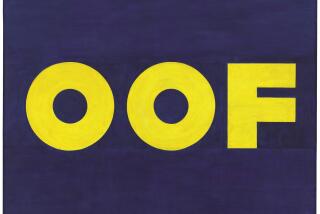‘Art is just a matter of how you interpret it.’ : One Way to Skin a Car--Artistically
- Share via
Outside the Fine Arts Building at Cypress College, a student paused and stared in disbelief.
On the sidewalk, a man was using a blowtorch to strip away pieces of a sports car.
“What’s happening to the car?” asked the student, Cindy Fox, 38, of Anaheim.
“I’m making a pelt of it,” said the workman, Dustin Shuler. “I think TRs look better as pelts, don’t you?”
The response wasn’t a joke. Shuler was, indeed, stripping a 1973 Triumph to make a “pelt,” a flattened profile of the car, which eventually will hang on display in the foyer of the Fine Arts Building.
Humor and Imagination
“I’m an artist in residence,” Shuler said. And this art, he said, “doesn’t require an art history education to understand.” It is “fairly simple. All you need is a sense of humor and a little bit of imagination.”
Shuler, 37, who lives in San Pedro, studied art at Carnegie-Mellon University in Pittsburgh and has created other unorthodox works--paintings, sculptures and so forth. But the artwork he enjoys most is making pelts of interesting old cars.
A finished pelt is something like a car seen as a bearskin rug, suitable for hanging from a wall.
The City of San Francisco recently bought one of Shuler’s car pelts. “It was a red 1971 Fiat, and it’s now hanging on a wall of the parking building at the Moscone Convention Center,” he said. “I think that’s a great place for something like this to be exhibited, don’t you?”
Pelts Sell at $20,000
Shuler said he sold that work, entitled “Fiat Pelt,” for a reduced price--$12,500--because it was for a civic project. Ordinarily, he said, a completed car pelt sells for about $20,000, which also is the value he will place on his work in progress at Cypress College.
The stripped-down-and-reassembled Triumph, Shuler said, will be titled “TR Pelt.” It will be on display in the college’s Fine Arts Building from Sept. 11 through Oct. 16, along with other works by Shuler.
Shuler bought the 1973 TR “minus its motor” for $400. Like a butcher working a prize piece of beef, he then carefully marked the carcass of the car, designating by line drawings the exact shape of each section to be cut away. The strips are then reassembled with strong wire loops. Students have been helping him with this part of the work.
“It’s like taking something that’s 3-D and making it 2-D,” he said.
Shuler got a burst of attention in 1980, when in a work of “performance art” he engineered the placing of a 20-foot steel “nail” through a vintage Cadillac at Cal State Dominguez Hills. He called that work “Death of an Era.”
One Student Unimpressed
To help pay for the event, Shuler stripped the Cadillac to sell parts as souvenirs. It was in stripping that car, he said, that he realized how much it was like skinning an animal. That, he said, is how his car pelts were born.
At least one student at Cypress College, however, wasn’t impressed. Tim Young, 29, of Tustin, watching Shuler work, said: “This sort of thing just becomes commercial after you’ve done it two or three times,” said Young. “When he (Shuler) did the skin of the Cadillac (in 1980), that was the original, the first. But I don’t see any need for keeping this up. The original is art, but anybody can buy a print.”
Most students who paused to watch, however, were enthusiastic after learning what the art project was about.
“You can make art out of anything,” said John Watts, 21, of West Covina. “Art is just a matter of how you interpret it.”
Russ Johnson, 62, of Rossmoor, who said he’s been taking art classes at Cypress College the past five years, beamed as he walked up to the car. “It must be art,” he said.
In response to another observer’s question, Shuler said: “I don’t have an artistic statement, per se, other than I like it. It’s all there. It’s all real obvious. It’s the analogy of cars to animals. . . . I’m going for the beauty of it.”
More to Read
Sign up for Essential California
The most important California stories and recommendations in your inbox every morning.
You may occasionally receive promotional content from the Los Angeles Times.













